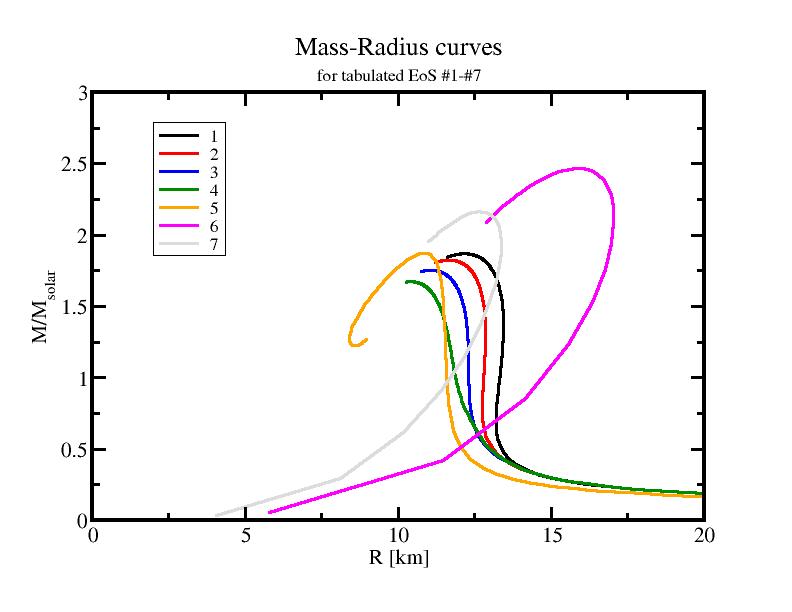Cold Quark Matter Equation of State
by Aleksi Kurkela, Paul Romatschke and Aleksi Vuorinen
Read article text as PDF.
Equation of State: Numerics
The following Mathematica 7 files can be used to make our quark matter equation
of state accessible as well as enable you to reproduce the results in our article.
Provided are:
-
A file that contains our equation of state in a form that can be evaluated numerically
and an interface that generates tabulated results for specific parameters: EoScalc. Use this file if you want to see the details
of our quark matter EoS, if you want to change something in the EoS, or if you want
an EoS for parameters for which we have not already provided a tabulated result (see below).
If you are just interested in e.g. the astrophysics results, you do not have to download this file.
-
A file that contains tabulated number densities for some parameter values:
tabulated.nb . You will have
to download this file if you want to use any of the following two files.
-
A file that performs the (homogeneous phase) matching of our quark matter EoS
to a hadronic matter EoS: HybridEoS.nb . Use this file if you want to generate a hybrid EoS and/or the Mass-Radius relation of
the associated hybrid compact star. Also, this file lets you output a tabulated version of the EoS
in nuclear physics units.
-
A file that generates our pure strange quark matter EoS: StrangeEoS.nb . Use this file if you are interested in strange star Mass-Radius relations and/or a tabulated version of the strange quark matter EoS in nuclear physics units.
-
For completeness, we also provide the C++ code that was used to numerically evaluate
the integrals I5,I6,I7 in our calculation here.
We will try to maintain and update these files (currently version 2.1). If you have trouble using them or discover an error please send us an email. (Older versions: v1, v2.0,
Changelog).
Equation of State: Tabulated Results
-
Case I Matching: Lambda_Msbar=0.378 GeV, m_s=0.07 GeV, Lambdabar=4 mu, Delta=0, B^1/4=89 MeV
(matching at mu_B=976 MeV)
-
Case I Matching: Lambda_Msbar=0.346 GeV, m_s=0.07 GeV, Lambdabar=4 mu, Delta=0, B^1/4=92 MeV
(matching at mu_B=987 MeV)
-
Case I Matching: Lambda_Msbar=0.378 GeV, m_s=0.1 GeV, Lambdabar=4 mu, Delta=0.1 GeV, B^1/4=113 MeV
(matching at mu_B=996 MeV)
-
Case I Matching: Lambda_Msbar=0.346 GeV, m_s=0.07 GeV, Lambdabar=4 mu, Delta=0.1 GeV, B^1/4=110 MeV
(matching at mu_B=1040 MeV)
-
Case II Matching: Lambda_Msbar=0.346 GeV, m_s=0.07 GeV, Lambdabar=4 mu, Delta=0, B=-(109 MeV)^4
(matching at mu_B=1290 MeV)
-
Pure Strange Quark Matter: Lambda_Msbar=0.346 GeV, m_s=0.07 GeV, Lambdabar=4 mu, Delta=0, mu_min=776 MeV
-
Pure Strange Quark Matter: Lambda_Msbar=0.346 GeV, m_s=0.07 GeV, Lambdabar=4 mu, Delta=0.1 GeV, mu_min=798 MeV
NOTE: For automation purposes the value of mu_0(Lambdabar) in Eq.(70) of our paper has been set to a common value
(0.31 GeV) for the above hybrid EoS,
rather than the value of mu where the total quark number density vanishes.
The difference between these definitions amounts to a redefinition of B. The quoted values for B above are for
mu_0=0.31 GeV.

For Comparison: Hadronic Matter Equations of State
-
Nuclear Matter,
based on an article
by A. Akmal, V.R. Pandharipande and D.G. Ravenhall,
converted from an article
by J.M. Lattimer and M. Prakash,
(original).
-
Nuclear Matter+ Hyperons, converted
from an article
by H.-J. Schulze, A. Polls, A. Ramos and I. Vidaña (V18, UIX, NSC89)
(original).
-
Nuclear Matter+Kaon Condensation, based on an
article by N. K. Glendenning and J. Schaffner-Bielich,
converted from an article
by J.M. Lattimer and M. Prakash,
(original).
For questions & comments please contact A. Kurkela via email: "kurkela AT phys.ethz.ch"
Last update: 15.03.2010
